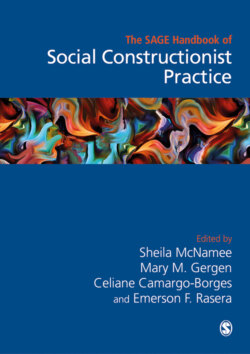Читать книгу The Sage Handbook of Social Constructionist Practice - Группа авторов - Страница 119
На сайте Литреса книга снята с продажи.
9 Transmaterial Worlding as Inquiry
ОглавлениеGail Simon and Leah Salter
At the core of the chapter is this simple narrative: we live in language and in a material world. When we research human life, we cannot see it or investigate it as separate from all else around us, whether ‘man-made’ and/or naturally occurring. Social constructionist inquiry studies how we use language to construct stories of self and other, of material and apparently immaterial, of that which is animate and apparently inanimate. The idea that humans alone story the world is anthropocentric. The world also stories humans. We are all involved in a worlding process (Barad, 2007) where the stories we generate have consequences. Inquiry that draws on social constructionist principles is guided by an ethical imperative to address practices of power by asking how stories are generated, how some truths are propagated over others, by whom, to what end. We aim to understand the relational effect of stories and how some stories carry more weight than others in different contexts.
Transmaterial worlding describes researcher activity as storying a diverse material world. It is a way to attend to the human condition and the vitality of other matter, to the interconnectedness between humans and non-humans, to life beyond species and life beyond what appears as death. ‘Worlding’ describes the constant process of intra-becoming within and between species and matter (Barad, 2007). As an approach to inquiry this includes not just observing, it includes challenging, perturbing, disrupting, transforming. There is no stasis, only movement. It involves a particular commitment to exploring incoherence between stories lived, stories told, stories ignored and stories re-written (Cronen and Pearce, 1999; McNamee, 2020). Deconstructing the relations in dominant discourses enables us to see how and why some voices (human or non-human) succeed in their stories being promoted and sold in some contexts over others. This has the potential to render visible the context and connection between everyday activities and their local and global contexts (Simon, 2012, 2013; Simon and Salter, 2019).
Research then becomes an opportunity to understand and disrupt power relations in order to challenge and reduce injustice. We offer examples of transmaterial worlding as a form of social constructionist inquiry and suggest signposts for how social constructionist research in a transmaterial world can honour societal, cultural, professional and other kinds of situated knowledge and know-how. These signposts propose coherent ways of validating and rendering transparent how we appraise what matters in social constructionist inquiry.
In this chapter, we extend social construction (i) to resituate the concept of social in the posthuman to broaden who/what counts as worthy of study and inclusion as a research participant; (ii) to recognise that social constructionist theory can be used for controlling self-interest in contrast with what we are calling co-construction which foregrounds collaboration and shared ethical meaning-making practices; and (iii) to introduce the concepts of transmaterial worlding and co-inhabitation as onto-epistemological understandings of relationships, movement, meaning-making practices, the influence of power between human and non-human parts of our worlds.
